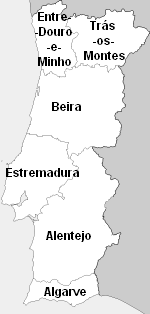Provinces of Portugal: Difference between revisions
Woohookitty (talk | contribs) m WikiCleaner 0.99 - Repairing link to disambiguation page - (You can help) |
Content elaboration |
||
| Line 1: | Line 1: | ||
{{Use dmy dates|date=September 2010}} |
{{Use dmy dates|date=September 2010}} |
||
The '''Provinces of Portugal''', although today not recognized in law and disused, continue to exist as socio-cultural divisions within the territory. Along its history, Portugal has had various administrative reorganizations that subdivided its territory, using the title ''Province'', beginning with the [[County of Portugal]], which itself was just a Province of the [[Kingdom of León]]. |
|||
== Medieval provinces == |
== Medieval provinces == |
||
[[File:antigas Provincias Portugal.png|thumb|150px|Medieval six provinces]] |
[[File:antigas Provincias Portugal.png|thumb|150px|Medieval six provinces]] |
||
Revision as of 11:07, 20 February 2011
The Provinces of Portugal, although today not recognized in law and disused, continue to exist as socio-cultural divisions within the territory. Along its history, Portugal has had various administrative reorganizations that subdivided its territory, using the title Province, beginning with the County of Portugal, which itself was just a Province of the Kingdom of León.
Medieval provinces

- Entre-Douro-e-Minho Province
- Trás-os-Montes Province
- Beira Province
- Estremadura Province
- Alentejo Province
- Algarve (Reino do Algarve)
Provinces of 1832
On the continent eight provinces were created: Minho Province, Douro Province, Trás-os-Montes Province, Beira Alta Province, Beira Baixa Province, Estremadura Province, Alentejo Province and Algarve Province.
In the islands Madeira Province and Açores Province were created, the latter becoming divided 1833 into Ocidental dos Açores Province and Oriental dos Açores Province.
Eleven provinces of 1936

The Estado Novo adopted, from its beginning, a policy of regionalisation of the country. This regionalisation was written into the 1933 Constitution, by dividing mainland Portugal into provinces.
The provinces were created in 1936. The provincial division was based in studies of the geographer Amorim Girão, published between 1927 and 1930, which divided mainland Portugal in 13 "natural regions". There were created 11 provinces, corresponding each to one of the natural regions by Amorim Girão, with two exceptions: the natural regions of Trás-os-Montes and Alto Douro and the natural regions of Beira Alta and Beira Transmontana were united respectively into the Trás-os-Montes e Alto Douro Province and the Beira Alta Province.
Parallel to the division into provinces, the division into districts was maintained, whose borders did not conform to the provincial borders.[1]
The provinces were:
- Minho
- Trás-os-Montes e Alto Douro - natural regions of Trás-os-Montes and Alto Douro
- Douro Litoral
- Beira Litoral - in the south containing parts of Estremadura Province
- Beira Alta - natural regions of Beira Alta and Beira Transmontana
- Beira Baixa
- Ribatejo
- Estremadura
- Alto Alentejo
- Baixo Alentejo
- Algarve
References
- ^ José J. X. Sobral, As Divisões Administrativas de Portugal, ao Longo dos Tempos, AUDACES, 2008
